 Image search results - "suwa" Image search results - "suwa" |

JR Kami-Suwa Station
|
|

Castle tower
|
|

Lake SuwaYou can rent a bicycle at Kami-Suwa Station and ride along the lake shore.
|
|
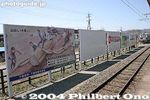
Billboard depicting Ki-otoshi (Log Drop) at Shimosuwa Station.
|
|
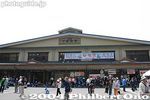
Shimosuwa Station on May 8, 2004. Here for the final three days of the Onbashira Matsuri's climax, the Satobiki when they haul the Onbashira logs to the Shimo-sha Shrines (Akimiya and Harumiya) and erect them.
|
|
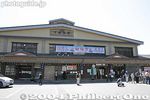
Shimosuwa Station 下諏訪駅
|
|

Onbashira monument in front of Shimosuwa Station. This Onbashira log was used in the opening ceremony of the Nagano Winter Olympics in 1998.
|
|
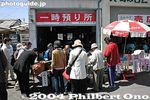
Store your luggage here. Not enough lockers at the train station so they provide this service. 400 yen/day.
|
|
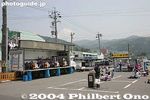
Entertainment stage in front of Shimosuwa Station.
|
|
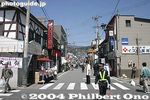
Go straight on this road in front of the station.
|
|
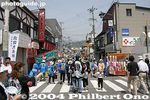
In front of Shimosuwa Station.
|
|
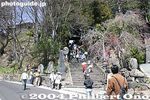
There are no buses nor taxis to where we want to go.
|
|
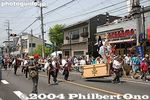
Parade of Nagamochi which are long chests. 長持
|
|
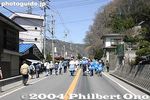
We had to walk it. This was April 10, 2004, one of the days for Shimo-sha Shrine's Yamadashi when they hauled the logs from the mountain forest.
|
|
|
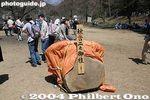
After walking for 30 min., we reached this place called Shimekake, a resting place for the logs which had been hauled from the mountains. This is Log No. 2 for Akinomiya Shrine. 注連掛
|
|
|
|
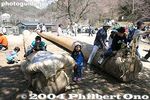
The logs will rest here for about a month until early May when they will be hauled to the shrines for the Satobiki erection.
|
|
|
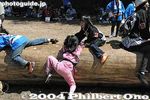
Here is where anybody can get on the logs and play.
|
|
|
|
|
|
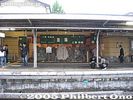
Kami-Suwa Station platform with hot spring foot bath
|
|
|
|

Net fishing
|
|
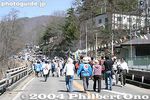
After the Shimekake, we walked further.
|
|
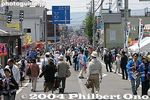
Crowded street
|
|
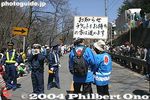
Until we were stopped here. Sign says that only people with tickets can proceed further. Yeah, we walked all this way only to be told we cannot go further. Our destination was the Ki-otoshi slope where the huge logs slide down for the Yamadashi.
|
|
|

We had to wait until the Ki-otoshi at 1pm was over. That's the one we wanted to see. But the place was already too full.
|
|
|

We had to wait until the 1pm Ki-otoshi log came out.
|
|
|
|
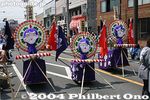
Nagamochi chest decorations
|
|

Log No. 4 for Shimo-sha Shrine's Akinomiya Shrine which already went down the big slope for Ki-otoshi (Log Drop) comes out at 1:30 pm. 秋宮四之柱
|
|
|

Log No. 4 for Shimo-sha Shrine's Akinomiya Shrine. 秋宮四之柱
|
|
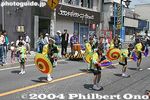
Umbrella dance
|
|

So after this log came out, we were allowed to proceed to the giant slope.
|
|
|

There it is, the slope.
|
|
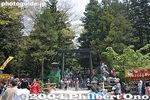
Shimo-sha Akimiya Shrine torii
|
|

We weren't the only ones there.
|
|
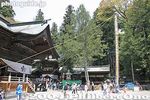
Shimo-sha Akimiya Shrine. That's a support pole for erecting the No. 1 Akimiya Onbashira log. 秋宮
|
|
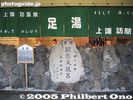
Hot spring foot bath
|
|

Takashima Castle
|
|
|
|

The Ki-otoshi slope, and one of the icons of the festival. This is the larger slope for Ki-otoshi compared to the one for the Kami-sha Shrine in Chino. 木落とし坂
|
|
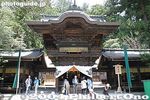
Shimo-sha Akimiya Shrine 秋宮 幣拝殿
|
|

The Ki-otoshi slope up close. Very rough-looking. 木落とし坂
|
|

Hole for the No. 4 Akimiya Onbashira log
|
|

People everywhere along the edge of the slope.
|
|

Small support poles.
|
|

The numerous people and trees made it impossible to see the slope itself.
|
|

Hole for the No. 2 Akimiya Onbashira log
|
|

It was very steep and uncomfortable to sit on, so I decided to leave this place.
|
|

Hole for the No. 2 Akimiya Onbashira log
|
|
|

Hole for the No. 2 Akimiya Onbashira log
|
|

I was forced to join this crowd.
|
|
|

The crowd extended all the way to the rear. All to see the 3pm Ki-otoshi log drop.
|
|
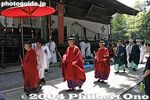
Shimo-sha Akimiya Shrine priests 秋宮
|
|

This was my view of the slope.
|
|
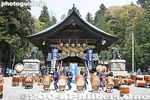
Taiko performance at Shimo-sha Akimiya Shrine's Kaguraden
|
|

Thank goodness for telephoto lenses.
|
|
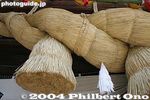
Shimenawa sacred rope on Kaguraden
|
|

Hot spring foot bathThat's not me in the picture.
|
|
|
|

We waited for the log scheduled to come down at 3 pm, but it was delayed by 2 hours...
|
|
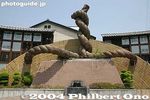
Onbashira Grand Park
|
|

Statue of Emperor Keitai in Asuwayama Park 継体天皇像The 26th Emperor of Japan is said to have hailed from Echizen Province.
|
|

We sat there for hours.
|
|
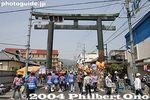
Harumiya torii 春宮大門
|
|

Finally, people pulling the log appeared.
|
|
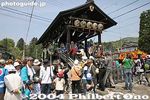
On the way to Harumiya Shrine, you see this bridge. It is a rest stop for the Akimiya Onbashira log procession. 下馬橋
|
|
|
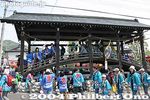
The bridge is normally closed to the public. In the old days, this bridge marked Harumiya Shrine's sacred area where even warlords had to get out of their palanquin or get off their horse out of respect before proceeding further. 下馬橋
|
|

The log pullers split into two.
|
|
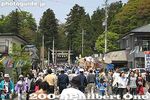
Harumiya Shrine ahead.
|
|
|

Harumiya Shrine torii 春宮
|
|

Then came the log, and a lotta dust which made it difficult to see what was going on.
|
|
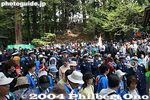
Harumiya has a little slope where the logs are slid down.
|
|

This was Log No. 1 for Shimo-sha's Harunomiya Shrine.
|
|

People everywhere.
|
|

But my camera captured the log going down, even though I could hardly see it. Onbashira Festival, Shimosuwa, Nagano. 木落とし坂 春宮一之柱
|
|

People along the small slope.
|
|

It was over after a few seconds. We walked for an hour from the train station and waited hours for just a few seconds of mostly dust.
|
|

This is May 9, 2004, the second day of Shimo-sha Shrine's Satobiki. Shimo-sha Shrine consists of two separate shrines called Akimiya and Harumiya.
|
|
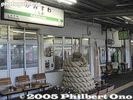
Onbashira rope on train platform
|
|
|

View from cycling road
|
|

Now we walked back together with hundreds of thousands of people...
|
|

Ropes to pull the Onbashira log from Harumiya Shrine.
|
|

Lake Suwa
|
|

The Ax Man. He cuts the rope which sets the log loose down the slope.
|
|
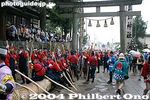
Log in Harumiya Shrine.
|
|

Lake Suwa
|
|

The log heading to the Shimekake resting place. If you don't like crowds, don't see this festival. Also see photos of Shimo-sha Satobiki.
|
|

Onbashira Log No. 1 already erected for Harumiya Shrine on May 8, 2004.
|
|

Lake Suwa and mountains
|
|

Erecting Onbashira Log No. 4 for Harumiya Shrine on May 9, 2004. 春宮四之御柱
|
|

Lake Suwa and mountains
|
|
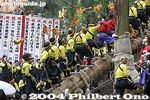
Erecting Onbashira Log No. 4 for Harumiya Shrine on May 9, 2004. Shimosuwa, Nagano. 春宮四之御柱
|
|

Lake Suwa and mountains
|
|
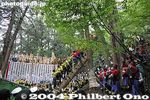
Everything is done with great fanfare, with these men riding on the log as it slowly rises by a system of cables and pulleys.
|
|
|

"Yoisa! Yoisa!"
|
|
|
|
|
|
|

Lakeside park
|
|
|

Lakeside park
|
|

Onbashira rope on train platform
|
|
|
|
|

When the log is erected, a banner is unrolled.
|
|

Lakeside park
|
|

The banner reads, "Thank you everyone for your cooperation."
|
|

Lake Suwa
|
|
|

Lake Suwa
|
|
|
|

Lake Suwa and bridge
|
|
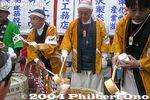
Sake is given for free.
|
|
|
|
|

Bridge across Kamaguchi Floodgate
|
|
|

Bridge across Kamaguchi Floodgate
|
|
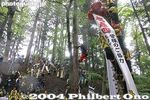
The men now descend from the log.
|
|
|
|

Kamaguchi Floodgate
|
|
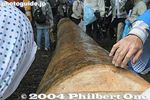
Onbashira Log No. 3 for Harumiya Shrine.
|
|

Carp caught from Lake Suwa
|
|
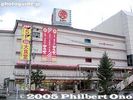
Dept. store
|
|

Takashima Castle 高島城
|
|
|
|

The base of the Onbashira log is reinforced by these smaller logs.
|
|

Lake Suwa during a warm winter.
|
|

Music Box Museum
|
|
|
|
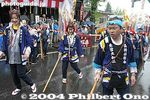
Parade
|
|
|

One Onbashira log at a rest stop.
|
|
|
|
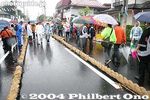
Ropes at rest
|
|

Oguchi Taro monument
|
|
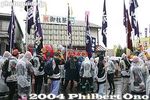
The logs are pulled by people from various districts or parishes in the Suwa region including Chino, Shimosuwa, Okaya, and Suwa.
|
|
|
|
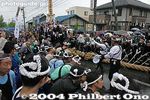
Another Onbashira log makes its way through.
|
|

Locomotive from Ohio, USA used in the 1930s.
|
|
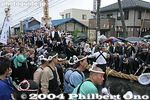
All the Onbashira logs are hauled manually by human hands from when it is cut in the mountain forest. No motor vehicles of any kind is used to haul the logs.
|
|

Sculpture in lakeside park
|
|
|
|
|

Water fountain
|
|
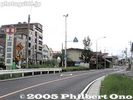
Kami Suwa Onsen (Spa)
|
|
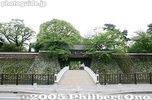
Bridge to castle park
|
|

Boat cruises
|
|
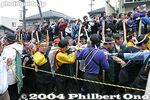
The log can move quite fast, even with all those people riding it.
|
|
|
|

Lakeside park
|
|
|
|

Ducks
|
|
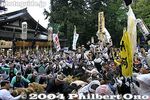
This looks like Log No. 2 for Akimiya Shrine.
|
|

Ducks fly away on Lake Suwa.
|
|
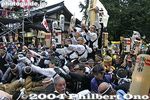
These people are from Suwa city.
|
|

Ducks fly to safety.
|
|

Ax man
|
|

Sculpture
|
|
|
|

Mother and child sculpture
|
|

Log standing by in front of Akimiya Shrine.
|
|
|

Onbashira-sai, Shimosuwa-machi, Nagano.
|
|

Lakeside park
|
|

Log standing by in front of Akimiya Shrine.
|
|

Playground
|
|
|
|
|
|

Lakeside park
|
|
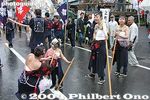
Parade continues even in the rain.
|
|
|
|

Water fountain and azaleas in spring
|
|
|
|

Water fountain and azaleas in spring
|
|
|

Map of lake shore area
|
|
|
|
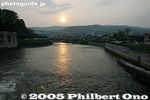
Tenryu River at sunset
|
|
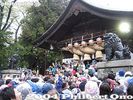
Now it's May 10, 2004, the last day of the Shimo-sha Satobiki. All four logs will erected at Akimiya Shrine on this day.
|
|

We waited in the rain for Onbashira Log No. 1 to be erected first at Akimiya Shrine at 10:00 am. However, we had to wait, standing up in the rain and in the crowd, for 2.5 hours before they finally started to raise the log.
|
|
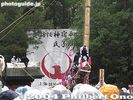
Finally, something to photograph.
|
|
|
|
|
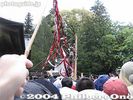
They threw out free streamers and I caught one. "Yoisa! Yoisa!"
|
|
|
|

They waved their pom-poms and cheered all the while.
|
|
|
|

Onbashira Festival. They included one woman.
|
|

Banners unfurled.
|
|

Now they descend.
|
|

The only woman on the log. After this log-raising, I had seen enough. This No. 1 log offered the best view of all the four Akimiya logs.
|
|
|
|
|
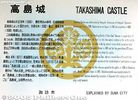
About the castle
|
|
|

Stairs to castle tower
|
|
|

Inside castle tower
|
|
|

Inside castle tower
|
|

Hot spring foot bath (free)
|
|
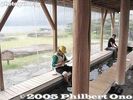
Hot spring foot bathThe place was covered due to rain.
|
|

View from castle tower
|
|

Hot spring foot bath
|
|

View from castle tower
|
|

View from castle tower
|
|

Hot spring foot bath
|
|
|

View of moat from castle tower
|
|
|
|

View of garden from castle tower
|
|

Oguchi Taro Statue and Biwako Shuko no Uta Song Monument. On the shore of Lake Suwa, Okaya, Nagano. 歌碑と小口太郎銅像This was where I first heard the song, "Biwako Shuko no Uta." In May 2004, I was in Suwa, Nagano Pref. to see and photograph the Onbashira Festival (held every 6 years). My hotel was in the neighboring city of Okaya on the shores of Lake Suwa.
I walked around the lake and came across this statue of Taro Oguchi and song monument. I was very surprised when I saw the word "Biwako" (Lake Biwa). This was Nagano, not Shiga, so it was most unexpected to see "Biwako" here. I read the song lyrics on the monument and was surprised and delighted to see the names of well-known places in Shiga.
The monument even had music box (seen on left) where you could hear three versions of the song. I immediately found it intriguing.
|
|

Taro Oguchi Statue and Song Monument in winter.
|
|

About Taro Oguchi.The song was written as a collaboration among boatmates, but Taro Oguchi (小口太郎) (1897-1924) is credited as being the main song writer. He was born in 1897 (Meiji 30) in Minato-mura village, now part of Okaya city on the shores of Lake Suwa in Nagano Prefecture.
He grew up in a loving and respected family and demonstrated an early talent for writing, music (violin and shakuhachi), and sports (judo, skiing, skating). Since he was the eldest son expected to take over the family home, there was opposition for him to go away for college. However, his father was persuaded to allow Taro to apply for college at the elite No. 3 High School (later to become Kyoto University). It was one of nine college-level schools in Japan, the No. 3 school being one of the most elite.
Contrary to family expectations, Taro passed the entrance exam, went school in Kyoto in 1914 and joined the rowing and speech clubs. In 1917, he wrote the famous song about Lake Biwa which first went public in 1918.
|
|

Statue of Oguchi Taro
|
|

Statue of Oguchi Taro 小口太郎銅像Short walk from JR Okaya Station. Walk toward the shore of Lake Suwa. The monument is near the mouth of Tenryu River.
|
|
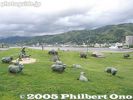
Sheep sculpture
|
|

Garden
|
|

Closeup of Taro Oguchi statueHe graduated in 1919 and furthered his studies at Tokyo Imperial University (now University of Tokyo) in the science department. In 1921, he invented the wired and wireless multiplex telegraph and telephone system which was patented in eight countries. He was an extremely bright young man with a promising future.
In 1922, he entered the university's aeronautical research institute as a researcher. However, his life soon took a downturn from 1923 when he received a military conscription notice. A love interest for marriage also did not work out as desired. His physical health deteriorated and he terminated his own life the following year in 1924 at age 26.
|
|

Rear view, looking toward Lake Suwa.
|
|
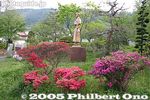
Side view of Taro Oguchi Statue and Song Monument in spring with azaleas.
|
|

Side view of Taro Oguchi Statue and Song Monument in winter. 小口太郎顕彰碑
|
|

Music box. Three versions of the song can be heard through a speaker by pressing a button. Also see the video at YouTube to hear the song.The monument included a music box where you could listen to three versions of the song through a speaker. I was immediately fascinated by the song when I heard it (together with the wind and waves of Lake Suwa).
|
|
|

Song monument with the entire lyrics of Biwako Shuko no Uta. On the shore of Lake Suwa in Okaya, Nagano. 琵琶湖周航の歌 全歌詞碑
|
|
|
|